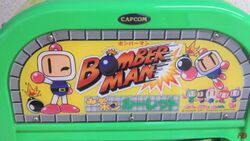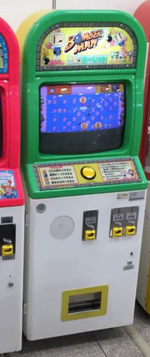Bomberman Misobon Roulette
|
Bomberman Misobon Roulette | ||||||||||||
|
| ||||||||||||
| ||||||||||||
Bomberman Misobon Roulette (ボンバーマンみそボンルーレット bonbāman misobon rūretto) is an arcade medal game developed by Hudson Soft, produced by EIGHTING and Capcom, and released exclusively in Japan. It is the second entry in Capcom's 1997 Single Medal Series.[1]
Game Description
The game is set in a small green arcade cabinet, and is played with only one button.
The game screen is comprised of a standard Battle Game stage complete with hard blocks, soft blocks, and unlit bombs. When the screen loads, Green Bomber, Blue Bomber, Red Bomber, and Black Bomber warp onto the map in random locations, each holding a large medal worth 1, 1, 5, or 10 medals, respectively. The player character is White Bomber, who sits in a Misobon cart at the upper-middle boundary of the map.
In the upper-left corner of the screen is a timer. In the upper-right corner is the the player's current item (left) and bomb stock (right).
To begin, the player must insert one to five medals,? Money is typically exchanged for medals in a separate machine gaining one bomb per medal. The medal value of each opponent Bomberman is also multiplied by the number of medals inserted (for a maximum of 5, 5, 25, and 50). Lastly, for each medal inserted after the first, the timer is increased by one second. Once a medal is inserted, the roulette at the upper-right corner of the screen will begin to spin.
Roulette
Once a medal has been inserted into the game, the roulette will begin to spin. The player may slow the roulette to a halt by pressing the button. One of four items may be obtained:? Items are not named, but descriptions are displayed on the cabinet
- Full Fire - Firepower becomes the maximum.
- Bomb-Up - Bomb stock increases by one.
- Fire-Up - Firepower incresaes by one.
- Skull - Movement speed of the Misobon cart increases.
The chosen item (except for the Bomb-Up) remains in effect until the end of the round.
Gameplay
After the roulette phase is over, a three second timer counts down to the beginning of the game. Once gameplay begins, White Bomber will automatically move around the perimeter of the screen in the clockwise direction. The four opponent Bombermen begin moving randomly around the field, actively avoiding the player's bombs. In the upper-left, the timer begins with ten seconds on the clock (plus up to four seconds for additional medals inserted). If this timer reaches zero, the game is over.
When the player presses the button, the timer will pause, and White Bomber will stop moving and throw a bomb onto the field, three squares forward. The bomb detonates with a base firepower of 2 after about three seconds. Unlit bombs that are hit by the explosion will explode with a firepower that matches the player's. If an opponent Bomberman is hit, he will be destroyed, and the player will gain medals equal to the number on the medal he was carrying. If a soft block is hit, it may reveal a single medal, which is also added to the player's earnings.
Once the bomb has finished exploding, if the player has another bomb in stock, White Bomber will resume his movement and the timer will resume its countdown. The object of the game is to earn as many medals as possible. When the game is over, all the medals the player earned are physically ejected into a metal cup at the bottom of the machine.
Trivia
- The tilesets used in the game are derived from Super Bomberman 3, and the other graphics, sounds, and music appear to be styled after the game, if not also lifted from it in some cases.
- While the Bomber Shuttle is similar in appearance to that of the opening cinematic of Super Bomberman 4, both the outside and inside feature unique art. The interior is structured similarly, but is coloured differently from its Super Bomberman 4 counterpart.
- The game can be set in a number of stages, which are arranged from tilesets taken from Super Bomberman 3. Known stages include Regular, Bukubuku Bomb, and Tsurutsuru Bomb from the Battle Game.
Gallery
References
The following videos were used to study the gameplay and translate the text on the cabinet:
Additional reference:
- ↑ 1.0 1.1 カプコン シングルメダルシリーズ・ビデオ筺体, CAPCOM, AOU '97 flyer, 1997.




